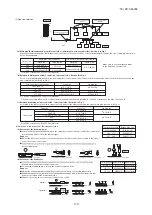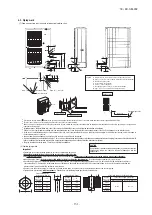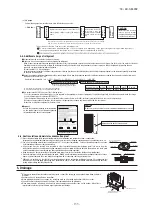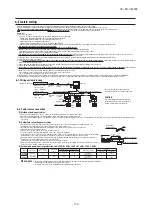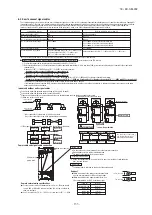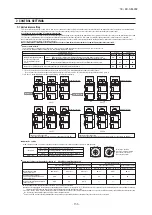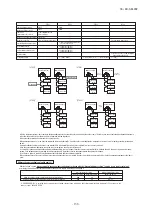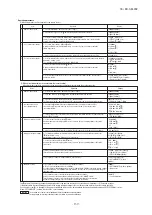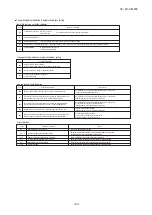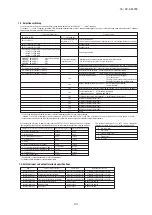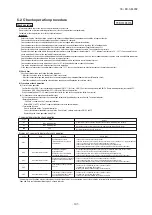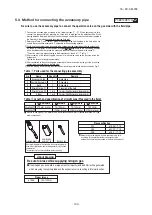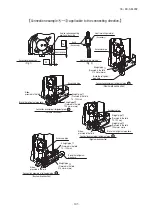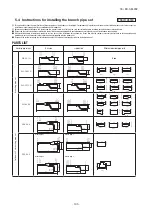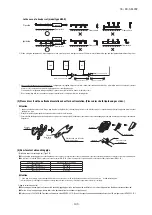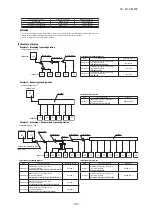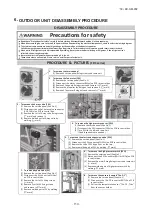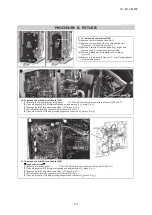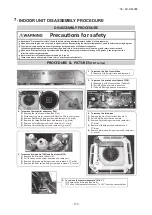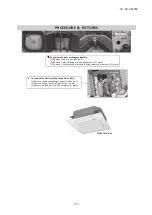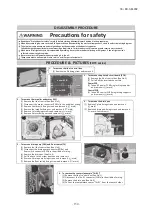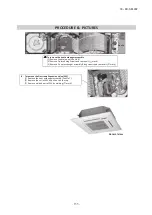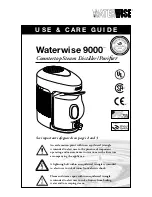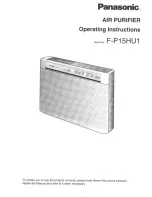
–
142
–
'18 • KX-SM-292
(1)
Make sure that a measurement between the power source terminal block and ground, when measured with a 500V megger tester, is greater than 1 M
Ω
.
(2) When the resistance of the signaling line terminal block is 100Ω or less before turning the power on, the power cables may be connected to the signaling line terminal block.
Check the wiring referring to the standard resistance value of 6-3.
(3)
Be sure turn ON the power source to supply power to the crank case heater 6 hours before operation.
After supplying the power to the crank case heater, the compressor may not start unless the time mentioned above elapses. (For protection of compressor)
In such occasion, the 7-segment LED shows “dL
○○○○
”. Wait till the temperature in the compressor rises sufficiently after turning power on to the crank case heater,
before starting the test run.
(4)
Make sure that the bottom of the compressor casing is warm
.
(5) Be sure to fully open the service valves (liquid, gas) for the outdoor unit.
Operating the outdoor unit with the valves closed may damage the compressor.
(6)
Confirm that the power is supplied to all indoor units. It could cause trouble if there is any indoor unit which is not powered.
The switch will continuously change the display indication to the next one in every 0.25 seconds when it is pressed for 0.75 seconds or longer.
If the Reset switch is pressed during an operation, the display indication returns to the one that was shown before the last Set switch operation.
Even if an indoor unit No. is changed in this mode, the registered indoor unit No. before address change mode is displayed when [I/U SELECTION
▼
] is shown.
When “SET COMPLETE” is shown, indoor unit No.’s are registered.
(2) When plural indoor units are connected to the remote control.
When plural indoor units are connected, you can change their addresses without altering their cable connection.
Address change mode
Selecting an indoor unit
to be changed address
Setting a new indoor unit No.
1
2
3
Setting a new outdoor unit No.
Ending the session
4
5
①
Press the AIR CON Unit No. switch for 3 seconds or longer.
②
Each time when you press the switch, the display indication will be switched.
③
Press the Set switch when the display shows “CHANGE ADD.
▼
”
The lowest indoor unit No. among the indoor units connected to the remote control unit will be shown.
④
Pressing the switch will change the display indication cyclically to show the unit No.’s
of the indoor units connected to the remote control and the unit No.’s of the outdoor units
connected with them.
⑤
Then the address No. of the indoor unit to be changed is determined and the screen switches to the
display “ SET I/U ADD.”
⑥
Set a new indoor unit No. with the switch.
A number indicated on the display will increase or decrease by 1 upon pressing the
▲
or
▼
switch
respectively.
⑦
After selecting an address, press the Set switch. Then the address No.of the indoor unit is determined.
⑧
The display will indicate the determined indoor address No. for 2 seconds and then switch to the
“ SET O/U ADD.” screen.
A default value shown on the display is the current address.
⑨
Set a new outdoor unit No. with the switch.
A number indicated on the display will increase or decrease by 1 upon pressing the
▲
or
▼
switch
respectively.
⑩
After selecting an address, press the Set switch.
Then the address of the indoor unit and outdoor unit are determined.
⑪
If you want to continue to change addresses, return to step
④
.
⑫
If you want to end the session (and reflect new address settings)
In Step
⑩
, press the
▼
switch to select “END
▲
.”
If you have finished changing addresses, press the Set switch while “END
▲
” is shown. While new settings
are being transmitted, “SET COMPLETE” will be indicated. Then the remote control display will change to
the normal state.
⑬
If you want to end the session (without reflecting new address settings)
Before you complete the present address setting session, press the “ON/OFF” switch.
Then the display is change to exit from this mode and switch the display to the normal state.
All address settings changed in the session will be aborted and not reflected.
[
I/U
002
]
(2sec)
[
I/U 002
]
(2sec lighting)
⇔[
SET O/U ADD.
]
(1sec)
⇔[
O/U
01
]
(Blink)
[
O/U
00
▲]
⇔[
O/U
01
]
⇔[
O/U
02
]
⇔ ・・・
⇔[
O/U
31
▼]
[
I/U 002
O/U 02
]
(2sec lighting)
→[
SELECT
]
(1sec lighting)
→[
I/U SELECTION
▼]
(lighting)
[
Press the switch
]
(1sec)
→[
SET COMPLETE
]
(2
-
10sec
lighting)
[
END
▲]
→[
SET COMPLETE
]
(2
-
10sec lighting)
→
Normal state
[
ON/OFF
]
→
Forced termination
[
SELECT I/U
]
(1sec)
→[
I/U 001 O/U 01
▲]
(Blink)
[
CHANGE ADD
▼]
⇔[
MASTER I/U
▲]
[
CHANGE ADD
▼]
[
I/U 001 O/U 01
▲」
⇔[
I/U 002
O/U 01
]
⇔[
I/U 003
O/U 01
]
⇔ ・・・
⇔[
I/U 016 O/U 01
▼」
[
SET I/U ADD.
]
(1sec)
→[
I/U 001
]
(Blink)
[
I/U
000
▲]
⇔[
I/U
001
]
⇔[
I/U
002
]
⇔ ・・・
⇔[
I/U
127
▼]
Turn on power to central control equipment after the addresses are determined.
Turning on power in wrong order may result in a failure to recognize addresses.
Item
Operation
Display
NOTICE
⑦
Set a new outdoor unit No. with the switch.
A number indicated on the display will increase or decrease by 1 upon pressing the
▲
or
▼
switch respectively.
[
I/U 000
▲」
⇔
[
I/U 001
]
⇔
[
I/U 002
]
⇔ ・・・
⇔
[
I/U 127
▼
]
[
I/U 002] (2sec Lighting)
→
[ SET O/U ADD.]
(1sec)
→
[
O/U 01
] (Blink)
[
I/U 001
O/U 01] (1sec)
→
[ SET I/U ADD.]
(1sec)
→
[
I/U
001
]
(Blink)
④
Set a new indoor unit No. with the switch.
A number indicated on the display will increase or decrease by 1 upon pressing the
▲
or
▼
switch respectively.
Item
Operating procedure
(1) When single indoor unit is connected to the remote control.
Address change mode
To set a new indoor unit No.
To set a new outdoor unit No.
1
2
3
①
Press the AIR CON No. switch for 3 seconds or longer.
②
Each time when you press the switch, the display indication will be switched.
[
O/U 00
▲
]
⇔
[
O/U 01
]
⇔
[
O/U 02
]
⇔ ・・・
⇔
[
O/U 31
▼
]
Operation
Display
③
Press the Set switch when the display shows “CHANGE ADD.
▼
”
and then start the address change mode, changing the display indication to the “Indoor Unit No.
Setting” screen from the currently assigned address.
⑤
After selecting an address, press the Set switch, and then the indoor unit address No. is defined.
⑥
After showing the defined indoor address No. for 2 seconds, the display will change to the “Outdoor
Address No. Setting” screen.
The currently assigned address is shown as a default value.
⑧
After selecting an address, press the Set switch, and then the outdoor unit No. and the indoor
unit No. are defined.
[CHANGE ADD.
▼
]
[CHANGE ADD.
▼
]
⇔
[MASTER I/U
▲
]
[
I/U 002 O/U 02] (2sec Lighting)
→
[
SET COMPLETE] (2sec Lighting)
→
Returns to normal condition.
[
I/U 002] (2sec)
●
7-segment display indication in automatic address setting
Code
Contents of a display
P30
P31
P32
P34
Code
Contents of a display
Unable to find any indoor unit that can be actually communicated with.
The number of the indoor units that can be actually communicated with is less
than the number specified in P33 on the 7-segment display panel.
The number of the indoor units that can be actually communicated with is
more than the number specified in P33 on the 7-segment display panel.
Starting address (P32) + Number of connected indoor units (P33) > 128
While some units are operating in the previous SL mode on the network, the
automatic address setting on multiple refrigerant systems is attempted.
Are signal lines connected properly without any loose connections?
Is power for indoor units all turned on?
Are signal lines connected properly without any loose connections?
Input the number of connected indoor units again.
Are signal lines connected properly without any loose connections?
Are the network connectors coupled properly?
Input the number of connected indoor units again.
Input the starting address again.
Input the number of connected indoor units again.
Perform manual address setting.
Separate old SL setting unit from the network
Arrange all units to operate in the new SL.
Code
A00
A01
A02
A03
A04
Contents of a display
Please check
Contents of a display
Cause
Code
E2
E3
E11
E12
E31
E46
Duplicating indoor unit address.
Incorrect pairing of indoor-outdoor units.
Incorrect adderess setting of indoor units.
Address setting for plural remote controllers.
Incorrect setting.
Duplicating outdoor unit address.
・
Incorrect manual address setting
・
Indoor unit address is set from plural remote controls.
・
Plural outdoor units are exist as same address in same network.
・
Automatic address setting and manual address setting are mixed.
・
Automatic address setting and manual address setting are mixed.
・
An outdoor unit number that does not exist in the network is specified
・
No master unit exists in combination outdoor unit.
Items that are to be set by the customer
Communication protocol
0: Previos SL mode
1: New SL mode
Polarity difinition
0: Network polarity not defined.
1: Network polarity defined.
AUX
During automatic address setting.
X: The number of indoor units recognized by the outdoor unit.
AUE
Indoor unit address setting is completed normally.
End
Polarity is defined. (Automatic address)
Completed normally.
Automatic address start
Input starting address
Specify a starting indoor unit address in automatic address setting.
(The communication plotocol is displayed ; display only)
P33
Input number of connected indoor units
Specify the number of indoor units connected in the refrigerant system in automatic address setting.
7-segment display indication in automatic address setting
Address setting failure indication
Error indication
Setting value for allocation of external input function
Name
Purpose (Factory default)
Specification
Operating side connector
With external input terminals closed With external input terminals open
Invalid
Invalid
Valid
Valid
Valid
Test run start
Cooling
Valid
Invalid
External input CnS1
External input CnS2
External input CnG1
External input CnG2
External output CnZ1
External output CnH
External output CnY
External operation input (Closed at shipping)
Demand input (Closed at shipping)
Cooling/Heating forced input (Open at shipping)
Silencing mode input (Open at shipping)
Spare output (External output)
Operation output
Error output
Non-voltage contactor (DC12V)
Non-voltage contactor (DC12V)
Non-voltage contactor (DC12V)
Non-voltage contactor (DC12V)
DC12V output
DC12V output
DC12V output
J.S.T (NICHIATSU) B02B-XAMK-1 (LF) (SN)
J.S.T (NICHIATSU) B02B-XARK-1 (LF) (SN)
J.S.T (NICHIATSU) B02B-XAEK-1 (LF) (SN)
J.S.T (NICHIATSU) B02B-XASK-1 (LF) (SN)
MOLEX 5566-02A-RE
MOLEX 5566-02A-BU
MOLEX 5266-02A
Valid
Valid
Invalid
Invalid
Invalid
Normal
Heating
Invalid
Valid
"0" : External operation input
"1" : Demand input
"2" : Cooling/heating forced input
"3" : Silent mode 1 *1
"4" : Spare
"5" : Outdoor fan snow guard control input
"6" : Test run external input 1 (equivalent to SW5-1)
"7" : Test run external input 2 (equivalent to SW5-2)
"8" : Silent mode 2 *2
"9" : 2 stage demand input
By changing the allocation of external input functions (P07-19) on the 7-segment, functions of external
input terminals may be selected. Inputting signals to external input terminals enable the following functions.
"0" : Operation output
"1" : Error output
"2" : Compressor ON output
"3" : Fan ON output
"4 – 9" : Spare
The external output function of CnZ1 can be changed by
changing the setting in P06 on the 7-segment display panel.
Control selecting method
Content of control
8. TEST OPERATION AND TRANSFER
9. CAUTIONS FOR SERVICING (for R410A and compatible machines)
(1) To avoid mixing of different types of oil, use separate tools for each type of refrigerant.
(2) To avoid moisture from being absorbed by the ice machine oil, the time for when the refrigerant circuit is open should be kept as short as possible.
(Within 10 min. is ideal.)
(3) For other piping work, airtighteness testing , vacuuming, and refrigerant charging, refer to section 4, REFRIGERANT PIPING.
(4) Diagnostic Inspection Procedures
For the meanings of failure diagnosis messages, please refer to the technical manual.
(5) 7-segment LED indication
Data are indicated when so chosen with the indication selector switch. For the details of indication, please refer to the technical manual.
(6) Internal wiring
After maintenance, all wiring, wiring ties and the like, should be returned to their original state and wiring route, and the necessary clearance from all metal parts should be
secured.
(2) Method of starting a test run for a cooling operation from an outdoor unit: please operate a remote control unit according to the following steps.
(a) Start of a cooling test run
○
Operate the unit by pressing the START/STOP button.
○
Select the “COOLING” mode with the MODE button.
○
Press the TEST RUN button for 3 seconds or longer.
The screen display will be switched from “Select with ITEM ”
→
“Determine with SET ”
→
“Cooling test run
▼
.”
○
When the SET button is pressed while “Cooling test run
▼
” is displayed, a cooling test run will start. The screen display will be switched to “COOLING TEST RUN.”
(b) Termination of a cooling test run
○
When the START/STOP button or the “TEMP SET ” button is pressed, a cooling test run will be terminated.
(1) Test run from an outdoor unit.
Whether CnS1 is set to ON or OFF, you can start a test run by using the SW5-1 and SW5-2 switches provided on the outdoor unit PCB.
Select the test run mode first.
Please set SW5-2 to ON for a cooling test run or OFF for a heating test run. (It is set to OFF at the factory for shipment.)
Turning SW5-1 from OFF to ON next will cause all connected indoor units to start.
When a test run is completed, please set SW5-1 to OFF.
Note: During a test run, an indoor unit cannot be operated from the remote control unit (to change settings). (“Under central control” is indicated.)
CAUTION
Please make sure that the service valves (gas, liquid) are full open before a test run. Conducing a test run with any of them
in a closed position can result in a compressor failure.
▲
▼
●
After completing the installation and test run, explain methods of use and maintenance to the customer, referring to the Instruction Manual. Ask the customer to keep the
installation manual safely together with the Instruction Manual.
●
Instruct the customer that the power should not be turned off even if the unit is not to be used for a long time. This will enable operation of the air-conditioner any time.
(Since the compressor bottom is warmed by the crank case heater, seasonal compressor trouble can be prevented.)
8-1. Before starting operation
7-2. Selection switching
7-3. External input and output terminals specifications
8-2. Test run
8-3. Transfer
*1 Control is switched when both the allocation of external input function (P07-10) and SW are changed.
(Example: To use CnS1 for the input of forced cooling mode, set P07 at 2 and SW3-7 at ON. To use CnS2 for the input of forced cooling mode, set P08 at 2 and SW3-7 at ON.)
*2 In the energy saving mode, the capacity restriction becomes effective even if no signals are input at external input terminals.
*1 Valid/invalid is changed depending on outdoor temperature.
*2 It is always Valid, regardless of outdoor temperature.
SW setting on PCB
SW5-5
J13: Closed (Factory default), J13: Open
J14: Closed (Factory default), J14: Open
J15: Closed (Factory default), J15: Open
P
○○
on 7-segment
SW3-7 to ON=1 *1
SW5-1 to ON + SW5-2 to ON
SW5-1 to ON + SW5-2 to OFF
Cooling test run
Heating test run
Communication method selection ON: Previous SL communication, OFF: New SL communication
External input switing (CnS1, CnS2 only) Closed: Level input, Open: Pulse input
Defrost recover temperature Closed: normal, Open: cold weather district
Defrost start temperature
Closed: normal, Open: cold weather district
Outdoor unit fan snow protection control ON time setting - 30 sec (at shipping) 10, 30-600 sec
Silencing mode setting 0 (at shipping) - 3: Larger values for larger effect
Allocation of external output (CnZ1)
Allocation of external input (CnS1)
Allocation of external input (CnS2)
Allocation of external input (CnG1)
Allocation of external input (CnG2)
Spare
Energy saving mode *2
2 stage demand mode
OFF: Disabled (at shipping)
000, 040, 060, 080 [%]
Pump down operation
Operation priority selection
SW4-5:OFF, SW4-6:OFF*1
80% (Factory default)
SW4-5:ON , SW4-6:OFF*1
60%
SW4-5:OFF, SW4-6:ON*1
40%
SW4-5:ON , SW4-6:ON*1
00%
ー
ー
ー
ー
ー
ー
ー
ー
ー
ー
ー
ー
ー
ー
ー
ー
ー
Close the fluid operation valve on outdoor unit and set as follows:
(1) SW5-2 on PCB to ON
(2) SW5-3 on PCB to ON
(3) SW5-1 on PCB to ON
Forced cooling mode
(It can be fixed at cooling with external input terminals open, or at heating with them short-circuited.)
Set external input function
allocation to “2” *1
Set allocation of external
input function to “1” *1
Inputting signals to external input terminals selects the demand mode.
(J13 short-circuited: Level input, J13 open: Pulse input)
0: First push priority (at shipping)
1: Last push priority
2: Priority of master unit’s setting operation mode
3: Priority of required major operation mode
Outdoor unit fan snow protection control
0: Control disabled (at shipping)
1: Control enabled
P01
P02
P03
P04
P05
P06
P07
P08
P09
P10
P11
~
Controls of outdoor unit may be selected as follows using the dip switches on the PCB and P
○○
on the 7-segment.
To change P
○○
on the 7-segment, hold down SW8 (increasing a number shown on the 7-segment display panel: one’s place), SW9 (increasing a number shown on the 7-segment
display panel: tens place) and SW7 (Data write/Enter).
Summary of Contents for FDC224KXZME1
Page 169: ... 168 18 KX SM 292 PHA012D402 ...
Page 170: ... 169 18 KX SM 292 Screw ...
Page 171: ... 170 18 KX SM 292 ...
Page 172: ... 171 18 KX SM 292 ...



